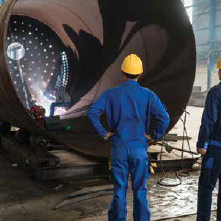How Welding Inspection Racine Makes Sure Safety And Security and Conformity
Wiki Article
Cutting-edge Methods to Fillet Weld Assessment and Screening: Enhancing Weld High Quality and Conformity Requirements
In the world of welding, the quality and integrity of fillet welds play a crucial duty in making certain the structural soundness and integrity of different commercial elements. With the constant drive for improved efficiency and conformity with stringent criteria, the exploration of cutting-edge techniques to fillet weld inspection and screening has become essential.Advanced Non-Destructive Screening Methods
Using state-of-the-art innovations, progressed non-destructive testing methods play a critical role in making certain the stability and top quality of fillet welds. These methods, such as phased variety ultrasonic screening (PAUT) and magnetic particle screening (MPT), offer detailed understandings into the weld's interior framework without causing any type of damages to the product. PAUT, for circumstances, makes use of several ultrasonic components to inspect the weld from different angles, giving an extensive visualization of possible flaws like lack of combination or fractures.In A Similar Way, MPT is effective in detecting surface-breaking problems by applying a magnetic area and iron fragments to the weld area. This technique is specifically useful for recognizing gaps that might jeopardize the weld's toughness. By using these advanced non-destructive testing techniques, weld examiners can precisely analyze the high quality of fillet welds, making certain conformity with industry standards and regulations. The ability to discover flaws early not just improves weld high quality however likewise stops expensive rework or failures in structural integrity, highlighting the relevance of these ingenious testing methods in welding evaluations.
Robotics and Automation in Assessment
The integration of robotics and automation has actually reinvented the evaluation procedure for fillet welds, improving efficiency and precision in high quality analysis. Robotics use accurate control and repeatability in evaluating welds, making sure constant and reliable outcomes. Automated systems can be configured to adhere to details assessment paths, making sure thorough protection of welds and reducing the danger of human mistake.Robotic assessment systems equipped with advanced sensing units can discover and gauge weld functions with high accuracy, providing in-depth information for analysis. These systems can determine issues such as cracks, absence of blend, and porosity, enabling punctual restorative actions to be taken. In addition, robotics and automation permit real-time information collection and analysis, supplying prompt feedback to operators and assisting in fast decision-making processes.
Additionally, making use of robotics and automation in fillet weld inspection improves general performance by lowering inspection times and enhancing assessment throughput. By simplifying the inspection process, producers can guarantee weld quality and compliance requirements are satisfied effectively, eventually causing set you back financial savings and boosted item top quality.
Making Use Of Expert System for Analysis
Artificial knowledge plays a crucial function in enhancing the effectiveness and precision of evaluation in fillet weld examination processes. By utilizing the power of AI, examiners can simplify the analysis of weld high quality and compliance standards, leading to a lot more reliable and specific outcomes. AI formulas can rapidly process large amounts of data from weld inspections, spotting issues or incongruities that might be challenging to relate to the nude eye. This sophisticated modern technology makes it possible for real-time tracking of weld high quality, permitting prompt restorative actions to be taken if any kind of problems are spotted.Moreover, AI systems can pick up from past examination data, continuously boosting their ability to determine possible defects and variances in fillet welds. This flexible learning capacity enhances the general top quality control procedure, decreasing the probability of human mistake and ensuring that welds meet the needed criteria. By incorporating man-made knowledge right into fillet weld analysis, industries can accomplish higher degrees of effectiveness, uniformity, and conformity in their inspection practices.
Portable Tools for On-Site Evaluation
 Enhancing field assessment performance, the fostering of portable tools reinvents on-site analysis procedures for fillet welds. These devices offer versatility and comfort, enabling assessors to perform thorough evaluations in different places, including remote or difficult atmospheres. Mobile devices such as ultrasonic screening gadgets, magnetic fragment inspection tools, and digital radiography systems supply real-time information and high-resolution imaging abilities, allowing fast decision-making and prompt comments on weld quality.
Enhancing field assessment performance, the fostering of portable tools reinvents on-site analysis procedures for fillet welds. These devices offer versatility and comfort, enabling assessors to perform thorough evaluations in different places, including remote or difficult atmospheres. Mobile devices such as ultrasonic screening gadgets, magnetic fragment inspection tools, and digital radiography systems supply real-time information and high-resolution imaging abilities, allowing fast decision-making and prompt comments on weld quality.One significant advantage of portable tools is their capacity to improve evaluation treatments, lowering downtime and boosting total efficiency. Examiners can quickly carry these tools to different work websites, getting rid of the requirement for carrying heavy machinery or elements to off-site facilities. Furthermore, the transportability of these devices advertises cost-effectiveness by reducing transportation expenditures and speeding up assessment timelines.
Furthermore, making use of mobile devices for on-site evaluation promotes positive high quality control measures, as assessors can quickly identify and resolve any type of possible welding flaws or discrepancies. By incorporating these ingenious technologies right into on-site evaluation techniques, welding professionals can guarantee conformity with market criteria and improve weld top quality, ultimately bring about enhanced architectural integrity and safety and security in various welding applications.
Assimilation of Data Administration Equipment
Having maximized on-site inspection procedures with the utilization of portable tools, the following phase includes the smooth integration of data administration systems to further improve performance and information analysis capacities in fillet weld evaluation and testing. Welding Inspection Racine. By incorporating information management systems into the assessment procedure, organizations can improve data collection, storage space, and evaluation. This combination enables for real-time surveillance of weld top quality, immediate identification of problems, and timely decision-making to fix any problems that may develop throughout the examination procedure
Information administration systems play a vital role in streamlining examination information, helping with easy gain access to Click This Link for licensed workers, and making sure data integrity and security. Via the integration of these systems, inspectors can generate extensive reports, track historical information for fad evaluation, and enhance general process performance. The assimilation of data management systems makes it possible for smooth communication between various stakeholders included in the evaluation process, promoting partnership and enhancing total high quality control steps. get redirected here Ultimately, the assimilation of data management systems offers to raise the criteria of fillet weld assessment and testing, guaranteeing compliance with market policies and boosting weld top quality.
Conclusion
Finally, ingenious strategies to fillet weld examination and testing have actually dramatically boosted weld high quality and conformity criteria. Advanced non-destructive screening methods, robotics, automation, fabricated knowledge, mobile tools, and data management systems have changed the way weld assessments are performed. By utilizing these technologies, markets can make sure that welds meet the required high quality requirements and laws, inevitably improving overall efficiency and security in welding processes.
By using these innovative non-destructive screening strategies, weld assessors can properly analyze the top quality of fillet welds, making certain conformity with industry criteria and laws. Mobile devices such as ultrasonic screening gadgets, magnetic bit evaluation devices, and digital radiography systems provide real-time data and high-resolution imaging capacities, making it possible for fast decision-making and instant comments on weld top quality.
Having actually maximized on-site assessment processes through the utilization of mobile devices, the next phase entails the smooth combination of data management systems to discover this info here further boost effectiveness and data evaluation capacities in fillet weld assessment and testing (Welding Inspection Racine). Inevitably, the combination of data monitoring systems offers to elevate the criteria of fillet weld evaluation and testing, making certain compliance with industry laws and improving weld quality
 In final thought, innovative strategies to fillet weld assessment and testing have considerably enhanced weld top quality and compliance criteria.
In final thought, innovative strategies to fillet weld assessment and testing have considerably enhanced weld top quality and compliance criteria.Report this wiki page